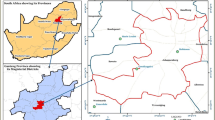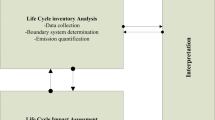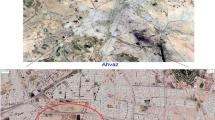Abstract
Life Cycle Assessment was applied to municipal planning in a study of waste water systems in Bergsjön, a Göteborg suburb, and Hamburgsund, a coastal village. Existing waste water treatment consists of mechanical, biological and chemical treatment. The heat in the waste water from Bergsjön is recovered for the district heating system. One alternative studied encompassed pretreatment, anaerobic digestion or drying of the solid fraction and treatment of the liquid fraction in sand filter beds. In another alternative, urine, faeces and grey water would separately be conducted out of the buildings. The urine would be used as fertilizer, whereas faeces would be digested or dried, before used in agriculture. The grey water would be treated in filter beds. Changes in the waste water system would affect surrounding technical systems (drinking water production, district heating and fertilizer production). This was approached through system enlargement. For Hamburgsund, both alternatives showed lower environmental impact than the existing system, and the urine separation system the lowest. Bergsjön results were more difficult to interpret. Energy consumption was lowest for the existing system, whereas air emissions were lower for the alternatives. Water emissions increased for some parameters and decreased for others. Phosphorous recovery was high for all three alternatives, whereas there was virtually no nitrogen recovery until urine separation was introduced.
Similar content being viewed by others
References
Baumann et al. (1993): Miljömässigaskillnader mellan ätervinning och förbränning av tidningspapper. (In Swedish. Environmental Differences between Recycling and Incineration of Newsprint). Reforsk FoU Report 71, Stiftelsen Rcforsk, Malrnö, Sweden, as cited inLindfoks et al. Nordic Guidelines on LifeCycle Assessment, Nordic Council of Ministers, Nord 1 995:20, Copenhagen
BP Statistical Reveiew of World Energy (1996): The British Petroleum Company p.l.c. 1996. Group Media and Publications
Britannica On-Line, http://www.eb.com
Clift, R.;Frischknecht, R.;Hutpes, G.;Tillman, A.-M.;Wkidema, B. (1997): Towards a Coherent Approach to Life Cycle Inventory Analysis. In Preparation, SETAC Working Group on Enhancement of Inventory Methodology
Dalemo, M.;Sonesson, U.;Björklund, A.;Mingarini, K.;Frostell, B.;Jönsson, H.;Nybrant, T.;Sundqvist, J.-O.;Thyselius, L. (1997):ORWARE- A simulation model for organic waste handling systems, Part 1: Model description. Accepted for publication in “Resources, Conservation and Recycling”
Emmerson, R.H.C.;Morse G.K.;Lester, J.N.;Edge, D.R. (1995): Life-cycle analysis of small scale sewage-treatment processes. J. Inst. Water Environ. Management 9 (3) 317–325
IPPC (1994): Climate Change 1994. Radiative Forcing of Climate Change and an Evaluation of the 1992 IPCC IS92 Emission Scenarios. Edited byHoughton, J. T. et al. Published for the “Intergovernmental Panel on Climate Change (IPCC)” by Cambridge University Press
Malmqvist, P.-A.;Björkman, H.;Stenberg, M.;Andersson, A.- C;Tillman, A.-M.;KArrman, E. (1995): Alternativa avloppsystem i Bergsjön och Hamburgsund. Delrapport från ECO-GUIDE-projektet. (In Swedish. Alternative Waste Water Systems in Bergsjön and Hamburgsund). Svenska vatten- och avloppsverksföreningen, VAV, Rapport 1995-03, Stockholm
Roeleveld, P. J.;Klapwijk, A.;Eggels, P.G.;Rulkens, W.H.;van Starkenburg, W. (1997): Sustainability of municipal wastewater treatment. Wat. Sci. Technol. 35 (10) 221–228
Schuurmans-Stehmann, A.M.;van Selbst, R.;Bijen, J. (1996): Life Cycle Assessment of sewerage systems. Presented at the SETAC Case Studies Symposium, 2 December 1996, Brussels.
Sonesson, U.;Dalemo, M.;Mingarini, K.;Jönsson, H. (1997): ORWARE - A simulation model for organic waste handling systems, Part 2: Case Study and Simulation Results. Accepted for Publication in “Resources, Conservation and Recycling”
Stenberg, M.;Andersson, A.-C.;KÄrrman, E. (1996): Miljökonsekvensbeskrivning tillämpad på alternativa avloppssystem i Bergsjön och Hamburgsund. (In Swedish. Environmental Impact Assessment Applied to Alternative Waste Water Systems in Bergsjön and Hamburgsund). Rapport 1996:1, Institutionen för vatten och avloppsteknik, Chalmers tekniska högskola, Gaöteborg
Steen, B.;Ryding, S.-O. (1993): The EPS-Enviro-Accounting Method. An Application of Environmental Accounting Principles for Evaluation and Valuation of Environmental Impact in Product Design. Swedish Waste Research Council, AFR report 11, Stockholm
Tillman, A.-M.;KÄrrman, E.;Nilsson, J. (1997): Comparison of Environmental Impact Assessment, Life Cycle Assessment and Sustainable Development Records. At the General Level and based on Case Studies of Waste Water Systems. Report 1997:1, Technical Environmental Planning, Chalmers University of Technology, Goteborg, Sweden
Tillman, A.-M.;Lundström, H.;Svingby, M. (1996): Livscykelanalys av alternativa avloppssystem i Bergsjön och Hamburgsund. Delrapport från ECO-GUIDE projektet. (In Swedish. Life Cycle Assessment of Alternative Waste Water Systems in Hamburgsund and Bergsjön). Rapport 1996:1, Teknisk miljöplanering, Chalmers tekniska högskola, Göteborg
Author information
Authors and Affiliations
Rights and permissions
About this article
Cite this article
Tillman, AM., Svingby, M. & Lundström, H. Life cycle assessment of municipal waste water systems. Int. J. LCA. 3, 145–157 (1998). https://doi.org/10.1007/BF02978823
Received:
Accepted:
Issue Date:
DOI: https://doi.org/10.1007/BF02978823
Keywords
- Anaerobic digestion
- waste water treatment
- biological waste water treatment
- case studies
- chemical waste water treatment
- Life Cycle Assessment (LCA)
- LCA
- mechanical waste water treatment
- municipal waste water systems
- nutrient recycling
- pretreatment
- waste water
- sewage
- sewerage
- urine separation
- waste water system
- waste water treatment




